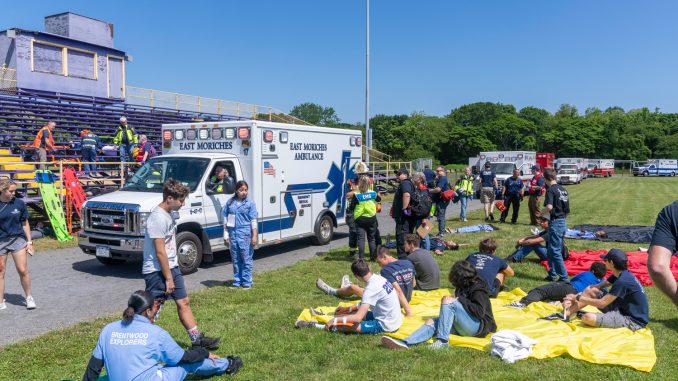
The screams echoed across the field at Greenport High School. A girl’s screech. A boy’s groan.
A long line of ambulances, lights flashing, parked along the track as first responders raced to each of the “victims” wounded by an active shooter.
Across the field, a cloud of smoke rose from a vehicle fire.
Inside the school building, dozens of officers prepared to confront the “shooter” who had caused all the carnage.
It’s a scene that has unfolded across the nation in reality. On Saturday, it was an elaborate training exercise meant to bring together various levels of law enforcement to practice how to respond to the unthinkable.
Chip Bancroft, the event organizer and owner of Firehouse Training Plus, said the training was a “big success.”
The two-part drill took place Saturday morning, when local police, firefighters and EMTs responded to the mock scenario.
The training came as the nation grapples with numerous mass casualty incidents. In May alone, shootings occurred at a Buffalo supermarket and an elementary school in Uvalde, Texas, within weeks of each other. Ten people were killed in Buffalo and in Texas, 19 children and two teachers were killed in one classroom, the worst school shooting since Sandy Hook in Connecticut a decade ago.
“The drill was extremely timely based on what’s going on in the country today and the most recent shootings, but in all actuality the planning for this drill had started back in February with the fire departments,” said Southold Town Police Chief Martin Flatley.
The drill began on the premise of a “shooter” at the school football field firing a weapon in all directions, leaving behind about 60 victims before fleeing inside the school building.
That’s when officers from the Suffolk County Police Department and Southold Town teamed up to neutralize the shooter, the chief said.
The drill was open to any law enforcement group in Suffolk County, Chief Flatley said, adding that about 72 officers participated.
As part of their training, police officers also attended to “victims” and reviewed lifesaving procedures. They reinforced their training on the use of tourniquets, packing wounds and more.
Local agencies on the football field, including around 24 ambulance companies representing departments from Mastic to Orient, dealt with the more than 60 casualties, representing a multitude of physical and mental injuries, according to Mr. Bancroft.
“We had some ‘patients’ that were in a catatonic state, others that were hysterical … some that immediately experienced PTSD,” Mr. Bancroft said.
The dead and wounded were played by volunteers from local Scouts and ROTC groups. They were described as one of the highlights of the training.
“The youth actors are doing an amazing job at really portraying injuries that they would have if this happened,” said Jackie Kanarvogel, one of the support staff attending the event from Human Understanding and Growth Services of Westhampton.

HUGS was invited by Mr. Bancroft to help make sure the training experience didn’t trigger serious anxiety or trauma among the young actors.
“This kind of reenactment can be very emotional,” Ms. Kanarvogel said. “We’re just here in a support capacity to give a debriefing after, for all of the youth, to help them shake any emotion … and make sure they’re in a good mental state after this is all over.”
Mr. Bancroft said the actors were so good that some of the EMS staff were affected by their performances after the drill.
One major takeaway from the event was that communication could be improved. In such a large scenario with so many different departments on site, it becomes difficult to communicate since each department uses a different radio channel.
“The communications portion of it is always a learning experience, and is always difficult to get through,” Chief Flatley said.
First assistant chief Alain DeKerillis of the Greenport Fire Department said his department learned, for their own safety, to wait until they’re cleared by police to enter into a scene.
Utilizing Suffolk County’s Major Emergency Response Vehicle was also a learning experience. Fire department volunteers learned to transport people who weren’t as critically injured as far west as possible to avoid overloading local hospitals and leave space available for those who need more urgent care.
“We learned, with 62 victims, that in a real-life situation, we would definitely have to mutual aid probably as far as, I’d say, up to Nassau County, because you really can’t strip every department,” Mr. DeKerillis said. “So we’d probably be better off, on a 62-victim count like that, [with] 46 to 50 ambulances … It just gave us that magnitude and scope.”
Mr. DeKerillis said he felt training should be done annually, adding that it was good to see all the departments working together.
“The more that we train, the better we get and then the more prepared we get,” he said.

